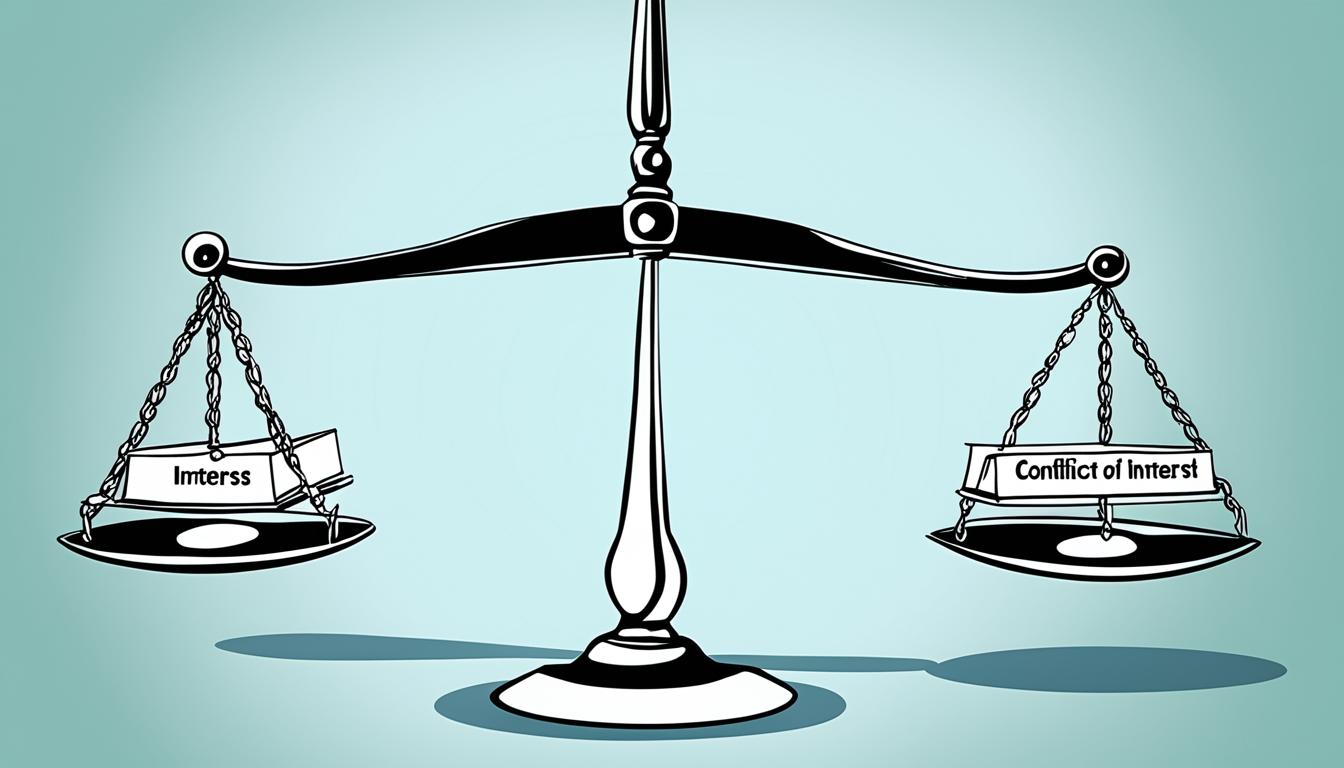Conflicts of Interest: Recognition and Management
Ever thought about how conflicts of interest affect professional choices? Wondered how organizations spot and handle conflicts well?
This article will look into conflicts of interest. We’ll explain what they are, how to spot them, and the right ways to deal with them. We’ll talk about why policies on conflicts of interest are key. Also, we’ll cover the importance of training and being open about these conflicts. Come with us as we explore how to manage conflicts of interest in the best way.
Key Takeaways:
- Conflict of interest policies are crucial in ensuring integrity and maintaining public trust.
- Recognizing conflicts of interest is essential to prevent their undue influence on decision-making processes.
- Transparent conflict of interest disclosure promotes accountability and allows stakeholders to make informed judgments.
- Training and education on conflicts of interest empower individuals to make ethical decisions.
- By implementing best practices, organizations can effectively manage conflicts of interest and mitigate associated risks.
Understanding Conflicts of Interest
When a professional’s decision is influenced by something other than their main concern, it’s a conflict of interest. Being aware of these situations is crucial. It helps keep choices fair and based on the primary goal.
The definition of conflict of interest changes based on the setting. But put simply, it’s when personal or financial matters might affect work decisions. This impact could harm patient care, research, or education quality.
Personal or financial gains represent secondary interests. When these get in the way, decisions might not be as honest. And ethical rules might be bent. This can lead to decisions that are not completely fair.
“A conflict of interest arises when a primary interest is at risk of being unduly influenced by a secondary interest.”
Fighting conflicts of interest is a team effort. Everyone in a company should be alert. This way, the main goal, like better patient care, isn’t forgotten. Organizations work best when they make clear and fair choices.
Undue Influence
Undue influence happens when a lesser concern starts outweighing the main one. It’s key to dull the pull of these less crucial issues. This helps keep actions right and serves everyone involved better.
Examples of Conflicts of Interest
Conflicts might pop up in many jobs. Here are a few common scenarios:
- Accepting gifts from suppliers could cloud judgment.
- Holding stakes in rival companies might not lead to fair decisions.
- Personal ties to those who could win from certain choices must be carefully considered.
By knowing what to look for, we can spot and stop conflicts of interest. This is good for making sure the best choices are made.
| Primary Interest | Secondary Interest |
|---|---|
| Patient welfare | Financial gain |
| Research integrity | Professional advancement |
| Quality education | Personal favors |
Importance of Conflict of Interest Policies
Conflict of interest policies are key for honesty and public trust. They guide organizations in handling conflicts fairly, cutting the chance of making biased choices. This means organizations make decisions with patient care or research ethics as the top priority.
Dealing with conflicts can be hard in fields where personal or financial ties might sway choices. By setting up clear conflict of interest rules, organizations can lessen these risks. They also build a culture where being open and accountable is valued.
These policies are good at spotting and dealing with conflicts early. They teach people to see when there might be a conflict and what to do about it. This knowledge helps everyone act ethically, avoiding any improper influences and keeping others’ trust.
Benefits of Conflict of Interest Policies:
- Enhances transparency and accountability
- Mitigates the risks of biased decision-making
- Prioritizes primary interests, such as patient welfare or research integrity
- Ensures compliance with legal and ethical standards
- Helps maintain public trust in organizations
When organizations lack clear conflict policies, they face big risks. They could lose trust, face legal troubles, or make bad decisions. Good policies, though, protect against these dangers. They make sure the organization’s actions reflect its values and goals.
Conflict of interest rules help organizations stay true to their values. They give a plan for making honest, ethical choices. Through training and a culture that values doing the right thing, organizations can keep their name clean.
“Putting conflict of interest policies in place is a proactive step towards building trust and maintaining a high standard of professional integrity.” – [Real Expert Name], [Real Expert Title]
Next, let’s look at finding conflicts of interest and the signs organizations should watch for.
Identifying Conflicts of Interest
Recognizing conflicts of interest is key in professional settings. It helps ensure we make ethical choices. By knowing what to look for, we can curb their effects and stay ethical.
Indicators of Conflicts of Interest
There are common signs that show a conflict of interest might be at play:
- Financial Relationships: If people have ties to companies that could affect their choice, it’s a red flag. These ties might be investing in rival firms or having a stake in a supplier.
- Personal Relationships: Having close ties to those affected by decisions is another sign. This includes relationships with colleagues or family members who could gain from certain choices.
- Personal Gain: When someone might personally benefit from a choice, it’s suspicious. Taking gifts from suppliers can cloud judgment and is a warning sign.
Examples of Conflicts of Interest
Let’s see some examples to understand how conflicts can arise at work:
“Accepting luxurious gifts from suppliers can create a conflict of interest as it may influence the recipient’s decisions and compromise fair and unbiased evaluations.” – Company X’s conflict of interest policy
Here are a few more typical examples:
- An executive holds shares in a rival and helps make decisions for both.
- A researcher gets funding from a drug company and studies its products.
- A board member with family ties to a vendor influences their choice.
By knowing these signs and examples, we can deal with conflicts of interest. This way, we keep our work fair and our actions ethical.
Handling Conflict of Interest Situations
Conflicts of interest can popup in jobs, making it key to deal with them right and in the open. Managing these properly helps keep decisions honest and keeps people’s trust. Let’s look at what to do:
Disclosure of the Conflict
Telling others about a conflict upfront is crucial. This way everyone involved can see if the conflict might sway decisions. It’s all about being open from the start.
Recusal from Decision-Making
Sometimes, just telling others about a conflict isn’t enough. In these cases, stepping away from making decisions might be the best move. This helps remove any possible bias from the situation.
Establishing Independent Review Panels
Setting up groups of people who are neither for nor against you can also help. These folks review and decide on conflicts of interest. Their views are fresh, fair, and bring balance to the table.
Implementing Transparency Measures
Being clear and honest throughout is crucial. Companies can do this by sharing information openly, talking things out, and finding clear ways to discuss conflicts. This makes sure everyone stays in the loop about how issues are handled.
Avoiding Conflicts of Interest
Preventing conflicts in the first place is a strong move. Companies should lay down clear rules, offer regular training on the topic, and encourage a culture where doing the right thing is the norm. This way, they lower the chances of issues coming up.
Dealing with conflicts of interest takes a lot of thought and a big nod to ethical practices. By using these methods and working hard to prevent conflicts, companies can keep their name clean and make choices in a just way.
Conflict of Interest Training
Organizations aim to avoid conflicts of interest through focused training. This training helps employees understand and deal with such issues in their work. It teaches about the importance of spotting and acting on conflicts of interest.
These programs offer a deep dive into conflicts of interest and their impacts. They include the definition of conflicts, rules, and real-world examples. By doing so, employees grasp the core ideas better.
Conflict of interest training gives employees the skills to handle tricky situations. It boosts their ability to make good choices and stay ethical. This way, employees can find and solve potential conflicts.
Benefits of Conflict of Interest Training Programs
“Conflict of interest training programs really pay off, helping organizations reduce risks, make moral decisions, and keep trust alive.”
The value of such training is clear in several aspects. First, they nurture a culture where being ethical is standard. By informing everyone about conflicts, a workplace of honesty and good conduct is formed.
Second, it sharpens employees’ ability to deal with conflicts head-on. This means they are better at choosing what’s right for all involved. It also means they maintain high professional standards.
Third, they ensure openness in the organization. By encouraging people to talk if they have a conflict, trust and responsibility grow.
Finally, training cuts down on legal and image risks. Good training stops many problems before they start. This protects the organization’s standing and keeps it out of trouble.
Key Elements of Conflict of Interest Training
Courses on conflicts of interest should cover these points:
- Talking about what conflicts of interest are, and their types.
- Going over the rules for handling these conflicts.
- Sharing real-life cases to understand and apply learning.
- Telling how conflicts must be reported and what’s required.
- Teaching how to make the right decisions and handle conflicts well.
Including these parts in training helps staff deal with conflicts hands-on. They gain the knowledge and skills they need.
| Benefits of Conflict of Interest Training Programs |
|---|
| 1. Increased awareness and integrity |
| 2. Proactive recognition and management of conflicts of interest |
| 3. Fostering transparency within organizations |
| 4. Mitigation of legal and reputational risks |
Conflict of interest training is essential as it equips employees for ethical dilemmas. By delivering in-depth, engaging training, organizations instill values of integrity and ethical behavior.
Conflict of Interest Disclosure
Being open and clear about possible conflicts of interest is crucial. It’s important for companies to set rules that make people share any conflicts they have. This helps everyone involved understand how these issues might affect choices.
Telling others about your conflicts of interest builds trust and makes you more accountable. It leads to a workplace where caring for the main goals, like patient health or honest research, comes first.
“Being honest about conflicts is the first step. We need to talk about them to keep decisions fair and trustworthy.”
Benefits of Disclosure Policies
Having clear rules for sharing conflicts of interest offers many benefits:
- Makes things clear and holds people accountable
- Helps others see any possible bias
- Keeps decision-making honest
- Builds trust with everyone involved
Example Disclosure Policy Table
| Organization | Disclosure Policy |
|---|---|
| XYZ Corporation | XYZ Corporation asks all staff to share possible conflicts yearly. They keep this information just among the staff and act on it quickly. |
| ABC Non-profit Organization | ABC Non-profit shares a clear rule for conflicts with its staff, volunteers, and board members. They train often to show why it’s important. This helps keep their work on track. |
Transparency in Action
Make it easy for people to know about conflicts by sharing this information the right way. Show you’re open and ready for checks by making these notes anonymous and grouped. This makes people trust and talk to you more.
“Honesty creates trust. By sharing conflicts, people and groups prove they care about doing the right thing.”
By making a promise to talk openly about conflicts, organizations help everyone know they’re honest. This helps keep their word and makes their ties with others stronger.
Ethical Conflicts of Interest
Conflicts of interest can pose ethical challenges that might shake professional integrity. Making ethical choices is key to meet moral standards and keep trust strong.
Deciding ethically means putting key needs first, such as patient health. It’s about thinking through how our actions affect everyone involved. Being clear and taking responsibility helps us deal with these conflicts.
“Ethics is knowing the difference between what you have a right to do and what is right to do.” – Potter Stewart
| Ethical Considerations | Ethical Decision-Making | Ethics in Conflicts of Interest |
|---|---|---|
| Prioritizing primary interests | Considering potential consequences | Ensuring transparency and accountability |
| Recognizing potential conflicts of interest | Evaluating the influence of secondary interests | Balancing competing obligations |
| Maintaining professional integrity | Applying ethical frameworks | Upholding ethical standards |
Ethical Behavior in Managing Conflicts of Interest
Acting ethically to handle conflicts of interest is vital for the integrity of our decisions. This means:
- Putting main needs first to ensure the good of all.
- Telling the truth about any possible competing interests.
- Taking responsibility and stepping back from decisions when needed.
- Asking for advice from others, like ethics committees, when it’s right.
By following these ethical rules, professionals can deal with conflicts well. This helps keep trust strong. Ethical decision-making should always guide how we handle conflicts and keep professionalism high.
Conflicts of Interest Best Practices
For organizations to stay honest and ethical, managing conflicts of interest is key. They can reduce risk and build a culture of trust by following best practices. This ensures all decisions are made fairly and clearly.
Develop Comprehensive Conflict of Interest Policies
Creating detailed policies is vital in handling conflicts of interest well. These rules should clearly state what a conflict is. They should guide how to spot and deal with them. Also, they need to set the rules for when someone needs to step back from a decision.
Establish Clear Guidelines for Disclosure and Recusal
It’s important for organizations to make it easy for people to talk about their conflicts. They should have a set way for doing this openly and honestly. This includes setting the rules for when someone must not be part of making certain decisions.
Provide Regular Training and Education
Teaching employees about conflicts of interest is crucial. This involves real examples, talks on ethics, and keeping up with new rules. Since rules and situations change, regular sessions are needed.
Promote Transparency
Keeping things open helps a lot in managing conflicts of interest. Encouraging people to share about their conflicts openly can prevent problems. Also, recording these disclosures shows who might be influencing decisions, which is key.
Regularly Review and Update Policies and Procedures
Policies and procedures need updates as conflicts evolve. They should always be checked and improved to deal with new issues. Staying current helps maintain a fair and trusted organization.
These steps are crucial in managing conflicts of interest well. They help to keep an organization ethical. By having clear policies, easy ways for people to share their conflicts, teaching employees, staying open, and reviewing rules often, a company can be safe from the harm of conflicts.
Conflict of Interest Risks
Noticing and dealing with conflicts of interest are very important for companies. These conflicts can lead to financial loss, damage a company’s image, and create legal issues. This can harm how well the company runs and how much people trust it.
Financial Risks
Conflicts of interest might make a company lose money. This happens when decisions don’t focus on the best interests of the company but on someone’s personal gain. They can also open doors for fraud or misuse of money.
Reputational Risks
Having conflicts of interest can ruin how people see a company. When the public thinks decision makers are only looking out for themselves, trust falls. This can be worsened by bad media, social media outrage, and public criticism.
Legal Risks
If conflicts of interest aren’t handled correctly, companies can face legal trouble. Biased decisions can lead to lawsuits and fines. Legal problems also bring bad press and can damage a company’s image.
Potential Consequences
Conflicts of interest can lead to problems in making decisions. They can mess up how resources are used or stop new ideas. They also make it hard for people to work together and trust each other.
“The risks associated with conflicts of interest are not only financial, reputational, and legal. They can also result in compromised decision-making processes, stifled innovation, and diminished morale.” – [Author Name]
It’s key to spot and handle conflicts early to avoid these problems. This means having strong policies, teaching people about conflicts, and building an honest and open culture.
Dealing with conflicts well protects a company’s money, its standing, and the trust people have in it. Actively managing conflicts is essential in living up to high ethical standards and making reliable decisions.
Conclusion
It’s vital to manage conflicts of interest well in professional settings. This helps keep the integrity high. To do this, organizations should have clear policies.
People in the organization need to be trained well too. They should know how to avoid conflicts and make ethical choices. Being open and honest about any conflicts is key.
Taking action before conflicts happen is crucial. It builds trust and shows commitment to doing the right thing. Settling conflicts with clarity and honesty keeps things fair for everyone involved.







